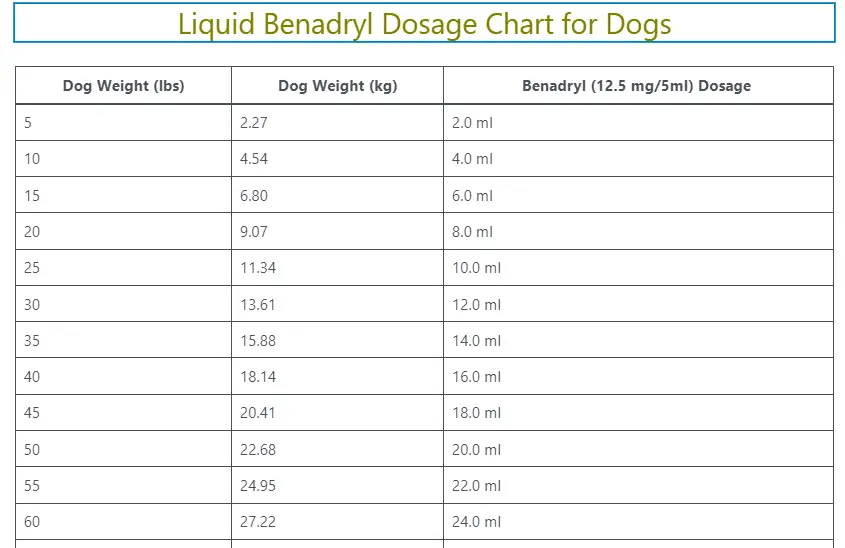Your furry friend’s health is a top priority, and when it comes to managing allergies or anxiety, Benadryl can be a lifesaver. However, determining the right dosage for your dog is crucial to avoid any adverse effects.
How Much Benadryl For Dogs?
The ideal dosage of Benadryl for dogs is 2–4 milligrams per kilogram or 0.9–1.8 milligrams (mg) per pound of body weight. For liquid Benadryl (12.5 mg/5ml), the ideal dosage is 0.9 ml/kg or 0.4 ml/lb. However, it’s crucial to consult your veterinarian before administering any medication to your pet, as the appropriate dosage may vary based on factors such as the dog’s size, health condition, and concurrent medications.
Benadryl Dosage Calculator For Dogs
To use the above Benadryl dosage calculator for dogs, simply input your pup’s weight and then select the unit either kg or lbs. The calculator for Benadryl dosage for dogs will provide instant results after clicking the ‘Calculate Dosage’ button. We suggest opting for the lower limit dosage.
How often Can I Give My Dog Benadryl?
Benadryl can typically be given to dogs every 8-12 hours, 2 to 3 times a day, but the frequency may vary based on the type and strength of the medicine and your dog’s specific needs. Your veterinarian can better decide the ideal dosage and dosing frequency of the medicine.
Benadryl Dosage Chart for Dogs by Weight
| Dog Weight (lbs) | Dog Weight (kg) | Benadryl Dosage (mg) |
|---|---|---|
| 5 | 2.3 | 2.1 – 4.1 |
| 10 | 4.5 | 4.1 – 8.2 |
| 15 | 6.8 | 6.3 – 12.6 |
| 20 | 9.1 | 8.2 – 16.4 |
| 25 | 11.3 | 10.4 – 20.7 |
| 30 | 13.6 | 12.4 – 24.7 |
| 35 | 15.9 | 14.6 – 29.2 |
| 40 | 18.2 | 16.4 – 32.8 |
| 45 | 20.5 | 18.8 – 37.5 |
| 50 | 22.7 | 20.7 – 41.4 |
| 55 | 25.0 | 22.9 – 45.8 |
| 60 | 27.3 | 24.7 – 49.5 |
| 65 | 29.5 | 27.1 – 54.1 |
| 70 | 31.8 | 29.2 – 58.4 |
| 75 | 34.1 | 31.3 – 62.7 |
| 80 | 36.4 | 33.3 – 66.6 |
| 85 | 38.6 | 35.4 – 70.8 |
| 90 | 40.9 | 37.5 – 75.0 |
The above Benadryl dosage chart for dogs is based on general recommendations. We highly recommend consulting with your veterinarian for the ideal dosage for your furry friend, taking into consideration factors such as size, breed, and any existing health conditions.
Liquid Benadryl Dosage Chart for Dogs
| Dog Weight (lbs) | Dog Weight (kg) | Benadryl (12.5 mg/5ml) Dosage |
|---|---|---|
| 5 | 2.27 | 2.0 ml |
| 10 | 4.54 | 4.0 ml |
| 15 | 6.80 | 6.0 ml |
| 20 | 9.07 | 8.0 ml |
| 25 | 11.34 | 10.0 ml |
| 30 | 13.61 | 12.0 ml |
| 35 | 15.88 | 14.0 ml |
| 40 | 18.14 | 16.0 ml |
| 45 | 20.41 | 18.0 ml |
| 50 | 22.68 | 20.0 ml |
| 55 | 24.95 | 22.0 ml |
| 60 | 27.22 | 24.0 ml |
| 65 | 29.48 | 26.0 ml |
| 70 | 31.75 | 28.0 ml |
| 75 | 34.02 | 30.0 ml |
| 80 | 36.29 | 32.0 ml |
| 85 | 38.56 | 34.0 ml |
| 90 | 40.82 | 36.0 ml |
| 95 | 43.09 | 38.0 ml |
| 100 | 45.36 | 40.0 ml |
Related Post: How to use Hibiscrub for dogs?
Importance of Veterinarian Prescription
Obtaining a veterinarian’s prescription before giving Benadryl to dogs is crucial for several reasons:
Veterinarians can determine the appropriate dosage of Benadryl based on your dog’s weight, health status, and specific needs. Giving the wrong dosage can lead to ineffective treatment or potential overdose, which can be harmful to your dog.
Certain canines may have underlying health conditions or be taking other medications that could interact with Benadryl. A veterinarian can assess your dog’s medical history and current health status to ensure that Benadryl is safe for them to use.
While Benadryl can help alleviate symptoms such as itching or allergies, it’s essential to address the underlying cause of these symptoms. A veterinarian can perform a thorough examination to determine the root cause of your dog’s symptoms and recommend appropriate treatment beyond Benadryl if necessary.
Like any medication, Benadryl can potentially cause side effects in canines. A veterinarian can advise you on what to watch for and how to manage any adverse reactions that may occur.
Giving medications to your dog without veterinary guidance can lead to misuse or inappropriate use. This can result in ineffective treatment, delayed recovery, or even exacerbation of your dog’s condition.
In many places, it’s illegal or against professional ethics for veterinarians to prescribe medications without first examining the animal.
Obtaining a veterinarian’s prescription ensures that you are following legal and ethical guidelines while also prioritizing your dog’s health and well-being.
Related Post: Can Dogs have Cramps on their Period?
Benadryl Uses For Dogs
Benadryl, which contains the active ingredient diphenhydramine, is sometimes used for dogs for various reasons, primarily for its antihistamine properties. Here are some common uses of Benadryl for dogs:
- Allergic Reactions:
- Benadryl can help alleviate symptoms of allergic reactions in dogs, such as itching, hives, swelling, and redness. It works by blocking the action of histamine, a substance in the body that triggers allergic responses.
- Motion Sickness:
- Some dogs experience motion sickness during car rides or other forms of transportation. Benadryl can be used to help manage the symptoms of nausea and vomiting associated with motion sickness.
- Anxiety:
- In some cases, Benadryl may be used to help calm anxious dogs, particularly during stressful situations such as fireworks, thunderstorms, or visits to the vet. However, its effectiveness for this purpose can vary, and other medications or behavioral techniques may be more appropriate for treating anxiety in dogs.
- Mild Sedation:
- Benadryl has a mild sedative effect on dogs, which can help them relax or sleep. This can be useful for dogs experiencing mild insomnia or restlessness.
- Insect Bites or Stings:
- Benadryl can provide relief from itching and swelling caused by insect bites or stings in dogs. It can help reduce inflammation and discomfort associated with these reactions.
FAQs
Can I give my dog Benadryl for itching?
Yes, Benadryl can be given to dogs to relieve itching caused by allergies or skin irritations. However, always consult your vet for the appropriate dosage.
How long does it take for Benadryl to work in dogs?
Benadryl typically starts to take effect within 30 minutes to an hour after administration, but this can vary depending on the individual dog and their condition.
What are the side effects of Benadryl in dogs?
Common side effects of Benadryl in dogs may include drowsiness, dry mouth, urinary retention, or gastrointestinal upset. If your dog experiences severe side effects, seek veterinary attention immediately.
Can I give Benadryl to my puppy?
It’s crucial to consult your veterinarian before giving any medication, including Benadryl, to puppies. Puppies have different dosage requirements and may be more sensitive to certain medications.
Is Benadryl Safe For All Dogs?
No, While Benadryl is generally safe for most dogs when administered correctly, it may not be suitable for dogs with certain health conditions or those taking specific medications. Always consult your vet before giving any medication to your dog.
Conclusion: How Much Benadryl For Dogs?
Finding the right balance of medication for your dog’s health needs is crucial for their well-being. By understanding how much Benadryl is safe for dogs and following proper administration guidelines, you can help alleviate their discomfort and improve their quality of life.
Remember, always consult your veterinarian before giving any medication to your dog, and closely monitor their response for optimal results.












![Can Dogs Eat Blood? 7 Side Effects [Expert Opinion]](https://petskor.com/wp-content/uploads/2022/04/Webp.net-resizeimage-12.jpg)
